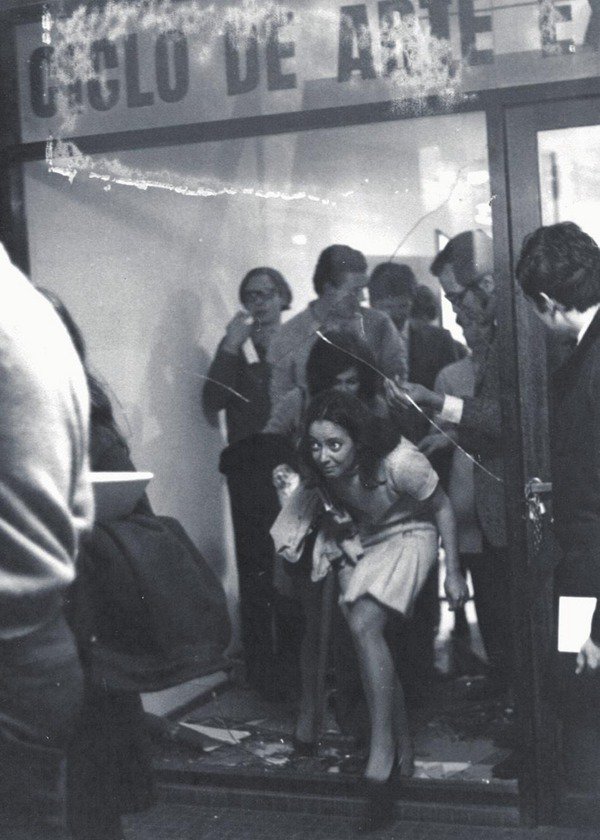Coup d'eclat
dal 14/9/2011 al 4/2/2012
Segnalato da
Ivan Argote
Marcela Armas
Sebastian Diaz Morales
Carlos Garaicoa
Monica Heller
Juliana Iriart
Aníbal Parada
Amalia Pica
Wilfredo Prieto
Judi Werthein
Lorena Zilleruelo
Francesca Agnesod
Guillaume Hervier
Andrea Rodriguez Novoa
14/9/2011
Coup d'eclat
Fort du Bruissin - Centre d'art contemporain, Francheville
The exhibition refers to the contemporary art scene in Argentina. The military architecture of the Fort is a signal of both entrenchment and the frontier, with its connotations of isolation and confinement: the special identity of the location and the events in Argentinean artistic life are the basis for the line of thought about the changes in the power structures that continue for a large part to govern our daily lives.

Curated by Francesca Agnesod, Guillaume Hervier and Andrea Rodriguez Novoa
Artists: Ivan Argote, Marcela Armas, Sebastián Díaz Morales, Carlos Garaicoa Monica Heller, Juliana Iriart, Aníbal Parada, Amalia Pica, Wilfredo Prieto, Judi Werthein, Lorena Zilleruelo.
Curatorial statement:
We have been invited to develop an exhibition relating to the contemporary art scene in Argentina in the setting of this now
disused military fort, which in the 19th century formed part of the defences of the city of Lyon. The military architecture of
the Fort, with its connotations of isolation and confinement, is a signal of both entrenchment and the frontier.
This site made us think straightaway of the Argentinean artist Graciela Carnevale: At the official opening of her exhibition
at Rosario in October 1968, she locked the public into the gallery premises for over an hour. This militant action came to
an end when a passer-by broke the window, covered at the time by posters for the exhibition. Once the public had been
set free, the artist handed out a pamphlet to them recounting the experience of imprisonment and forced participation they
had undergone, so drawing attention to the daily acts of violence perpetrated by the military forces during the dictatorship.
This artistic action echoed the situations of other countries in South America then under the oppressive rule of dictators, as
well as the wave of popular protest marking the end of that decade in the West, which spread opposition to authoritarian
regimes.
The special identity of the location and this outstanding event in Argentinian artistic life are the basis for our questioning of
the changes in the power structures that to a large extent determine our daily lives.
Today, more than forty years after that event, we feel it is relevant for us to question the forms of resistance that persist
and are evident within contemporary artistic aesthetic attitudes in Argentina, and South America more generally. We want
to elucidate what these unique territories enable us to perceive of the world, and what it is in personal stories that runs
through collective history.
These territories are today weakened by North-South bipolarity and the vertiginous gulfs between the wealth derived from
the dominant economic paradigms.
The show we are proposing sets out to give an account of how contemporary South American artists look at things, so
highlighting the signs of our contemporaneity and revealing the links and implicit correspondences that each of them
weaves across the world.
“Coup d’éclat” makes reference to an unrehearsed decision to speak up that attracts attention; to be more precise, in the
context of our show, the expression is a reference to the gesture of that passer-by who freed the people shut in by Graciela
Carnevale by breaking the gallery window. The artists brought together in this exhibition in their turn speak up regarding the
coercive powers of political and economic issues and the models the latter impose on individuals.
Some, often with irony, criticize the workings of the dominant system and uncover its contradictions; others reflect the
ambiguous role of the frontier and the separatist entrenchments that result from it. Yet others divert the relationship to the
structures of power, displacing their symbols and decontextualizing their functions, or question collective memory and the
staging posts through which each person fashions his or her own identity.
We are pleased to thank Victoria Noorthoorn, head curator of the 11th Lyon Biennial for her contribution within the project.
We also thank all the artists in the exhibition and the following galleries:
Galleries: Elba Bénitez - Madrid, carlier I gebauer - Berlin, Figge von Rosen - Berlin / Cologne, Nogueras Blanchard -
Barcelona, Diana Stigter - Amsterdam.
Fort du Bruissin / Administrator: Christophe Moussé / Stage manager of the exhibition: Vincent Desmures.
Built after the Franco-Prussian War of 1870 by General Seré de Rivières, described as the “19th-century Vauban”, the Fort
du Bruissin is part of the defence system of France’s eastern frontier, and particularly of the city of Lyon. This dug-out fort
covering more than 3000 sq. m. is located in 10 hectares of woodland. After being restored and renovated by the municipality
of Francheville in partnership with the State, the Rhône-Alpes Region and the Rhône Department, since 2008 it has housed
a centre of contemporary art.
Image: © Graciela Carnevale - Ciclo de Arte Experimental - Cycle of Experimental Art. Rosario. Argentina, 1968. Photo documentation : Carlos Militello
Visitor Services: Dephine Baudras, médiator +33 (0) 4 72 13 71 00 I fortdubruissin@mairie-francheville69.fr
Press contact: Françoise Dumas, Head of Communication board I +33 (0) 4 78 59 02 66 I fdumas@mairie-francheville69.fr
Exhibition: 15 September 2011 - 5 February 2012
Opening: Friday 16 September - 18.30
Fort du Bruissin, centre d’art contemporain de Francheville
Chemin du Château d’eau, 69340 Francheville
Open : Friday, Saturday & Sunday 14.00 - 18.00
European Heritage Days: 17 September 14.00 – 19.00 & 18 September 10.00 – 19.00
Free Entry



